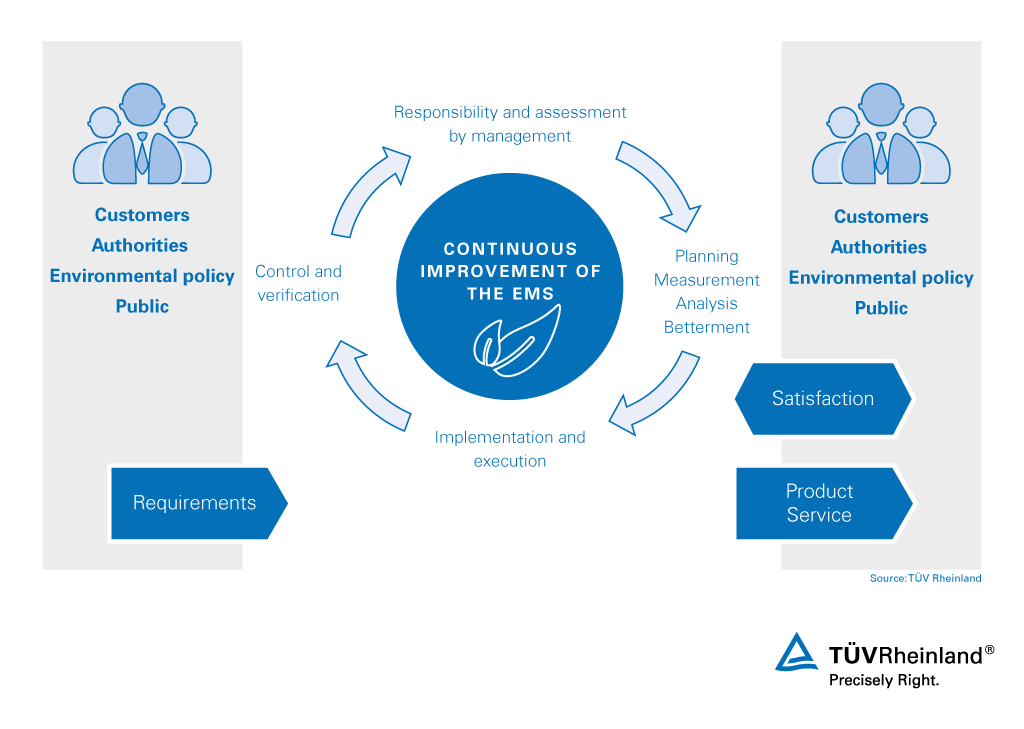ISO 14001 for environmental management system (EMS)

Content
- What is the ISO 14001 certification
- Why is obtaining the ISO 14001 certification critical
- Successful implementation of professional environmental management
- Make an impact on the environment and sustainability with our ISO 14001 certification
- How to establish an effective environmental management system
- How to enhance your environmental performance with ISO 14001 certification
- Most asked questions regarding ISO 14001 certification
Enhance credibility and environmental impact with TÜV Rheinland ISO 14001 certification

Take control of your environmental impact and position your company as a leader in sustainability with an ISO 14001-certified environmental Management System (EMS).
With over 140 years of expertise, TÜV Rheinland is your trusted certification partner across the globe. We ensure that our ISO 14001 certification services are tailored to help you meet your environmental goals, stay ahead of regulations, and improve efficiency. Our auditors ensure your environmental management system is effective, sustainable, and aligned with both international standards and local regulations. By choosing TÜV Rheinland, you gain a partner that enhances your corporate reputation and supports long-term success.
What is the ISO 14001 certification?
- The certification ISO 14001 is an internationally recognized standard for environmental management that helps organizations like yours improve sustainability practices while reducing negative environmental footprints.
- The ISO 14001 standard outlines requirements for creating, implementing, and maintaining an EMS, including principles for continuous improvement. It covers areas such as waste reduction, resource conservation, and legal compliance.
- ISO 14001 is applicable across industries, offering a customizable framework for businesses aiming to adopt sustainable practices and achieve their sustainability goals.
- A successful EMS orients your company towards sustainability and ensures continuous improvement through appropriate measures. The internationally recognized standard ISO 14001 supports these activities by applying a tried and tested system.
Why is obtaining the ISO 14001 certification critical?
Expert environmental management is no longer considered a ‘nice-to-have’, but rather a strategic instrument. Only those who systematically manage emissions, recycling and the use of natural resources today, will be able to sustain their business model tomorrow.
As of 2020, global certification saw a 5.5% increase*, underscoring the growing demand for ISO 14001 certification.*Source: Most recent ISO Survey.
ISO 14001 provides your organization with a robust framework to systematically manage and reduce environmental impacts, helping you meet regulatory requirements and demonstrate a tangible commitment to sustainability.
ISO 14001 certification also enhances your image with customers, partners and employees and sends a clear signal of your commitment.
Organizations adopting the ISO 14001 standard benefit in multiple ways:
- Boost resource efficiency and reduce waste
- Lower operational costs
- Assure stakeholders that environmental impacts are measured and managed
- Gain a competitive edge within supply chains
- Unlock new business opportunities
- Ensure compliance with environmental regulations
- Build trust with stakeholders and customers
- Enhance overall environmental impact
- Consistently manage environmental responsibilities
Enhance sustainability, reduce costs, and gain a competitive edge. Contact our certification experts today to get started!
Amendment 1: Changes of ISO standards regarding Climate Change
| Amendment 1 | 504 KB | Download |
Successful implementation of a professional environmental management - an effective instrument for long term success
Correctly understood and implemented, an environmental management system reduces your costs, improves legal clarity, fosters ecological awareness among your employees, promotes your corporate image, and allows potential sources of error to be identified at an early stage. In this regard, the ISO 14001 certification is a very effective instrument for your business.
When environmental management is developed in accordance with the ISO 14001 standard, a viable and sustainable balance can be reached between economic demands and the prevention of ecological pollution. Only when both these aspects are in harmony, can we speak of truly sustainable positioning.
That’s because sustainability involves more than matters such as the reduction of emissions, waste and wastewater, or the targeted use of resources. Correctly understood and implemented, an environmental management system also reduces your costs, improves legal clarity, fosters ecological awareness among your employees, promotes your corporate image, and allows potential sources of error to be identified at an early stage.
During our audits, our experts work with you to uncover potential for optimization. Plus, the certificate itself is a key element in ensuring your company will continue to be perceived positively into the future – by both society and regulatory authorities.
Let TÜV Rheinland help your business achieve its sustainability goals and secure long-term success!
Our experts answer frequently asked questions
| FAQs - Questions and Answers on ISO 14001 | 200 KB | Download |
Make an impact on the environment and sustainability with our ISO 14001 certification
In the past, corporate environmental protection was primarily aimed at systematic monitoring of on-site impact, in particular with regard to statutory compliance. Today, professional environmental management systems (EMS) work strategically, making employees aware of environmental protection and preventing negative environmental effects.
A successful EMS orients your company towards sustainability and ensures continuous improvement through appropriate measures. The internationally recognized standard ISO 14001 supports these activities by applying a tried and tested system. ISO 14001 certification also enhances your image with customers, partners and employees and sends a clear signal of your commitment.
We are ready to support you as an experienced certification partner.
How to establish an effective environmental management system with TÜV Rheinland
As an internationally acknowledged and accredited certification body, together with you, we establish an effective environmental management system that meets regulatory standards and drives sustainable growth in these five simple steps:
- Pre-audit (optional): pre-evaluation by auditors
- Certification audit: checking the effectiveness of your environmental management system
- Conferral of certificate and entry in our online certificate database, Certipedia
- Annual surveillance audits
- Re-certification after three years and extension of the continuous improvement process
Our experienced certification experts support your business at each of these stages to ensure compliance, efficiency, and sustainability—creating value that lasts.
Partner with TÜV Rheinland today to build a strong, effective environmental management system for your business.
Not ready yet or unsure about getting certified?
Contact us to explore how ISO 14001 can elevate your sustainability efforts.
How to enhance your environmental performance with ISO 14001 certification?
An environmental management system certified by us in accordance with ISO 14001 is valid and recognized worldwide. It provides a trend-setting path towards personal responsibility and self-commitment. In the meantime, it has become a reliable way for many companies to improve and demonstrate their environmental performance.
With ISO 14001 certification, you uncover weak points in your environmental management system and create the basis for a continuous and verifiable improvement process. You reduce environmental risks, conserve natural resources and sustainably improve your environmental performance. Active and effective environmental protection requires not only modern technologies, but also an effective environmental management system. A certification is an increasingly important success factor in competition.
The High-Level-Structure (HLS) standardizes the structure of the ISO Management Standards. This higher-level structure enables you to combine management systems and thus build an integrated management system.
Ready to improve your environmental performance? Contact TÜV Rheinland today to start your ISO 14001 certification process.

Most asked questions in regard to ISO 14001 certification
Our Sustainability Initiatives
Nothing less than the future is at stake. Companies, institutions, public authorities and each and every one of us can play a positive role in shaping the path to tomorrow. We provide you with comprehensive support to ensure that you operate safely, sustainably and efficiently for many years to come.
Disclaimer: At TÜV Rheinland, the neutrality, objectivity, independency and impartiality of our activities are of utmost importance. Our assessment and audit activities follow these values in compliance with the applicable accreditation requirements. All the necessary structural, organizational and processual measures are in place in all levels of the organization in order to avoid conflicts of interest (e.g. rigorous separation of consultancy and certification) and to ensure impartiality. We do not offer or provide management system consultancy by an accredited certification body for management systems. Within the TR Group, we ensure a minimum 2-year interval between management system consultancy and certification activity for the same costumer.
Contact













